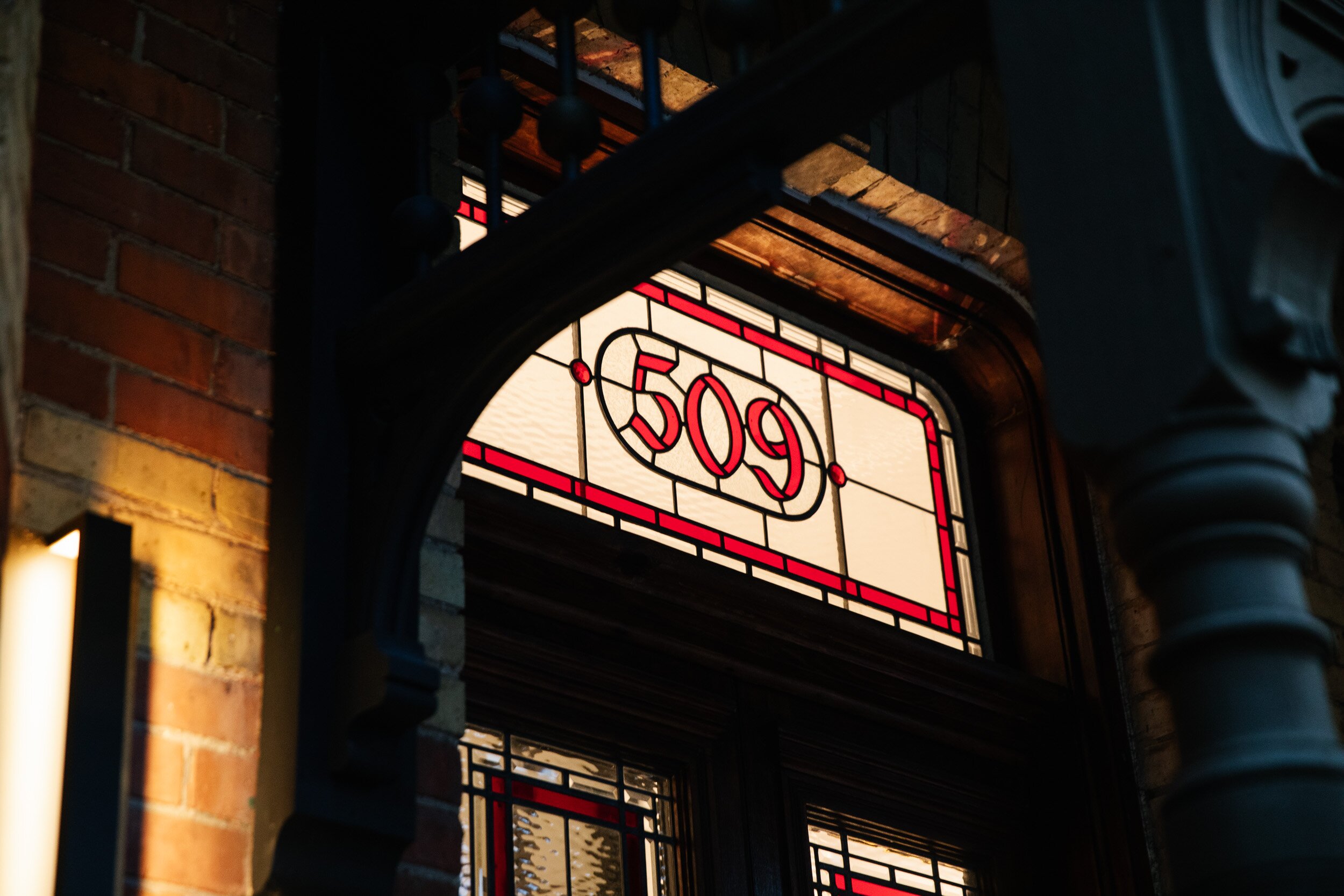
The home at 509 Adelaide St. West has been turned into a showroom and event space by TPL, a Toronto-based boutique lighting supplier. JOSH GEELEN/JOSH GEELEN
Generally, when a big retailer purchases a heritage home, there’s not much reason to strike up the brass band and throw a parade.
While it’s true that it’s a small victory since the home has been chosen because it suits their brand – and we heritage aficionados can assume the exterior will stay the same or be improved – the very nature of big city retailing means little will remain of the interior save for perhaps a fireplace.
Not so with family-owned TPL, a Toronto-based boutique lighting supplier and their newly christened “The Adelaide Project,” located in a designated heritage home at 509 Adelaide St. W., near Bathurst Street.

From the street, the house still scans as residential. JOSH GEELEN/JOSH GEELEN
“A lot of love went into this project,” says creative director Clarisa Llaneza, a Parsons School of Design-educated thirty-something who also
calls a historic Cabbagetown house her home.
Walking along Adelaide, the first thing a passerby will notice is, ironically, nothing. There is no blaring signage in the yard and no plaque
on the gate; the front door is not plate glass peppered with the usual credit card decals or an hours of operation sign. No, the 2 1/2-storey semi
– built by William Clarke in 1883 on former military land along with Nos. 511, 505 and 507 – still reads as a private residence.

An engraved stone 'doormat' greets visitors in the entryway. JOSH GEELEN/JOSH GEELEN
“It’s a home for the design community,” Ms. Llaneza says. She then mentions Soho House, a members-only bar/restaurant housed in a pre-
Confederation building about 1½ kilometres to the east: No sign on that building either, only a heritage plaque. “So that’s the idea; it is an
intimate space, it’s exclusive. We’re never going to have a massive party here. We have to protect the house … you won’t appreciate it if there’s too many people.”

JOSH GEELEN/JOSH GEELEN

The artwork on the walls is supplied by Paul Petro Contemporary Art. JOSH GEELEN/JOSH GEELEN
How refreshing. And before the term “snobbery” pops into your head, Gentle Reader, know that the Adelaide Project is indeed open to the
public, but by appointment only, and, generally speaking, only if one is looking to purchase lighting. Or art. Or furniture. To explain, the artwork
on the walls, for instance, has been supplied by Paul Petro Contemporary Art and it’s likely that, one day, Mr. Petro himself may hold a wine-and cheese reception at the house, since it continues to have a fully functioning (and very domestic) kitchen, provided by Trevisana. Or, perhaps, an architect who has a relationship with TPL might schedule a meeting with a client at 509 Adelaide rather than at her office, so that the two can look at and discuss lighting options or perhaps go over millwork drawings in a quieter, cozier space (one day, perhaps, a Globe and Mail architecture columnist may speak to a small group about heritage issues).

The building features a fully functional kitchen provided by Trevisana. JOSH GEELEN/JOSH GEELEN
Now just one month old (after almost two years of renovation), the Adelaide Project is a flexible space for Toronto’s design community, says
Ms. Llaneza, and the possibilities are endless: “We’re going to do a movie night in the parlour. We’re going to do, who knows, trivia for designers,
things such as that. So the whole idea is to educate, to nurture, to bring together.”

Grooves from thousands of ascents and descents mark the home's original staircase. JOSH GEELEN/JOSH GEELEN
And design folks will want to come together there. Open the original front door – crowned with a stained glass street number – and an
engraved stone “doormat” greets the eye. Step inside and, after one notes the restored plaster rosette over one’s head (there are still holes where
the gas line once came through) or the original staircase’s grooved treads from thousands of ascents and descents, the keen aficionado will spot the
rippling, imperfect plaster wall, highlighted by a ceiling fixture. “By lighting it, it brings out the shadows, you notice it more,” Ms. Llaneza says. “We could’ve done light just focused on the art.
“I believe in contrast, light-and-shadow, old-and-new.”

Super modern lightning offers a striking contrast against the home's traditional walls and mouldings. JOSH GEELEN/JOSH GEELEN
As one strolls through the front room, it’s a real pleasure to see another sort of contrast: All of the super modern lighting, much of it circular,
displayed against the rectilinear walls, windows and moulding. And although the baseboard had to be replaced here, it’s pretty accurate if a
little higher than the original (long story).
The foyer’s (original) ceiling arch that frames the stairway has been reinterpreted on the second floor; as one climbs the stair, a black-painted,
niche-like opening that cradles a cluster of illuminated globes comes into view. It’s a dramatic moment. Up here, also, is Ms. Llaneza’s office, a large
boardroom and a lovely bedroom that’s crying out for some sort of residency program with lighting or furniture designers, architects, or
glass artists.

The bedroom, like much of the building, features dramatic lighting. JOSH GEELEN/JOSH GEELEN
In the basement, although the ceiling height is somewhat low, the team has managed to pull a few aces out of their sleeves by using reclaimed
wood to great effect on a wall, by installing a generous washroom and making a feature out of wireless lighting control boxes (and as a side
note, Ms. Llaneza says the lighting in the home will change frequently).

The designers made the most of the low-ceilinged basement. JOSH GEELEN/JOSH GEELEN
When TPL got their hands on the home, it looked very different. Owned by a real estate agent, everything had been spray-painted white, many
appliances had been removed and there was only one small bathroom. In addition, there was asbestos in the ceiling and the original floors
“couldn’t be sanded down any more” so they had to go, Ms. Llaneza says; upstairs, only subfloor remained. The house was pretty much a dead spot
on an otherwise lively Toronto street.
“It’s bringing the house back to life,” Ms. Llaneza says. “We want people to come in, we want people to enjoy it and appreciate it, and be inspired
and learn, and us learn from them.”
One thing the Adelaide Project immediately teaches us, I think, is how to celebrate the little pieces of Toronto’s heritage.
***
This article was originally published in The Globe and Mail.
